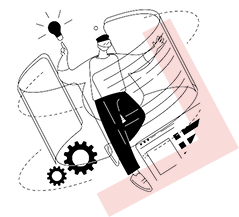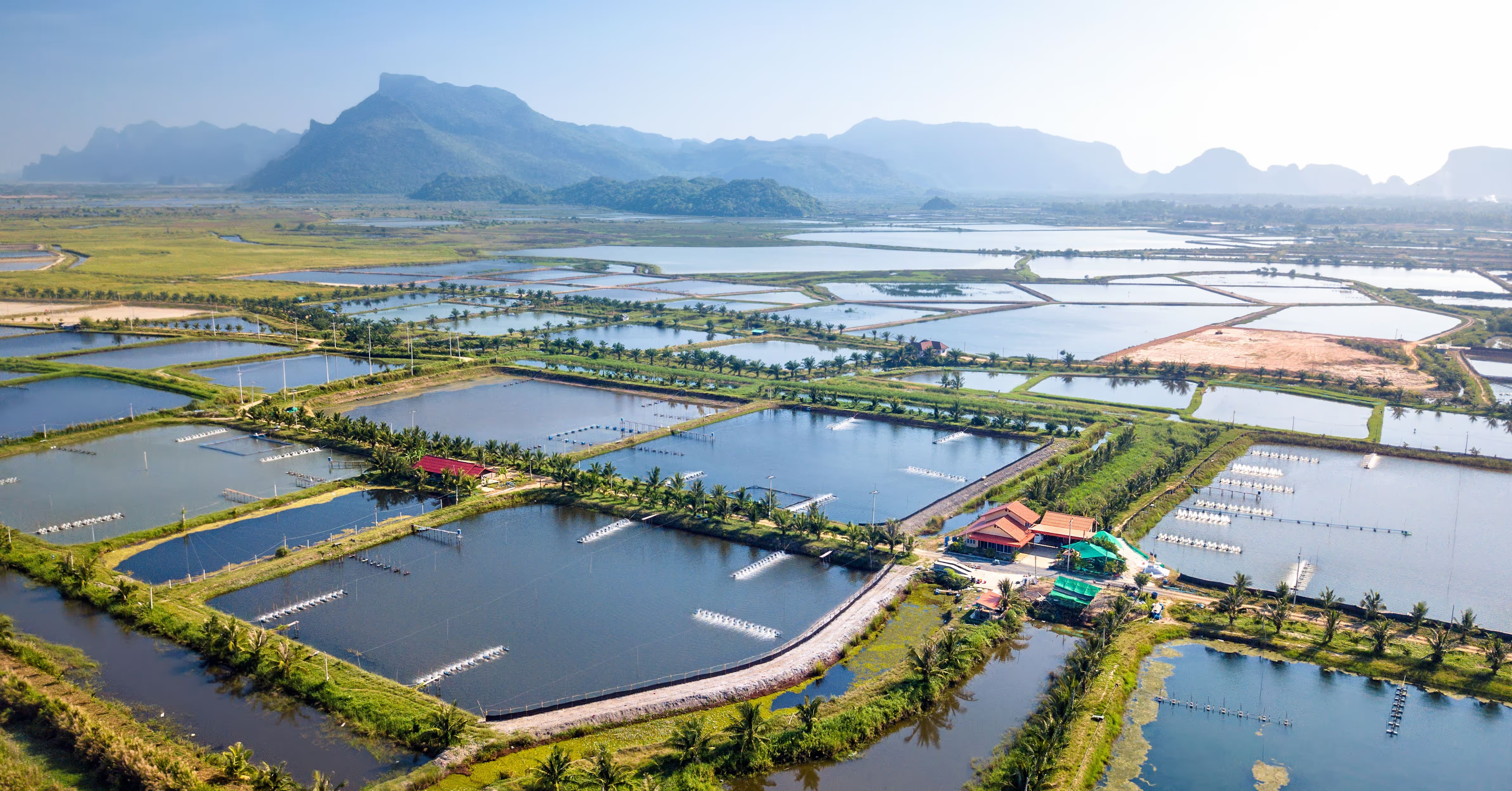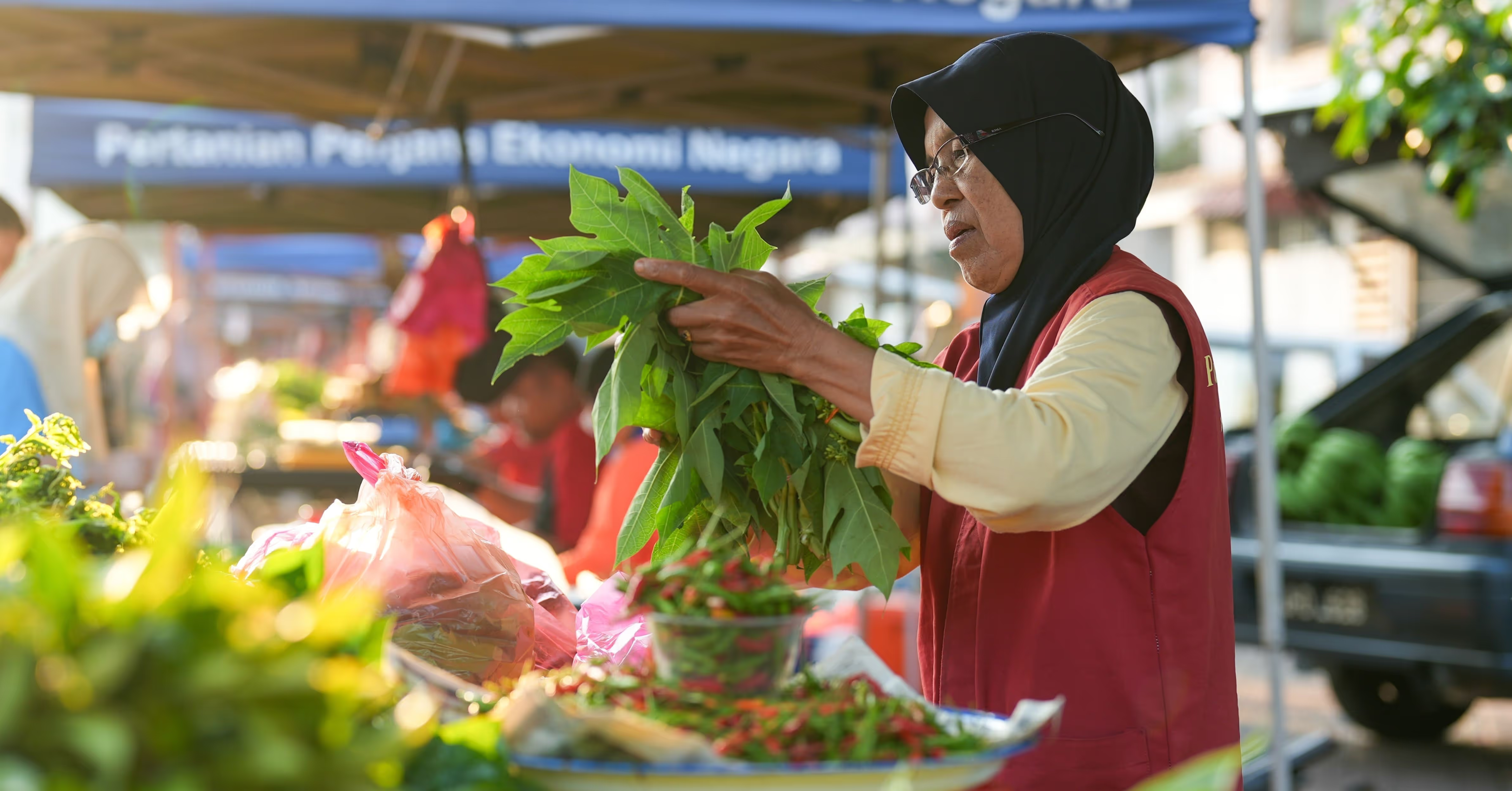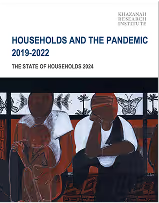
Aim of this article
In this article, the first of a two-part series, we compare the costs of four modes of transportation which are common in the Klang Valley area. We highlight the mode which is the most cost-efficient. The four modes of transportation are:
- Car
- Taxi (regular taxis and using MyTeksi)
- Uber
- A combination of taxis and trains
Uber is a platform similar to the MyTeksi mobile application, but instead of having registered taxi drivers to provide the transport service, Uber matches passengers with independent contractors (basically anyone registered with Uber and has a car).
Details of the calculations can be accessed through this excel file.
The second part of the series, discusses how urban transportation has been affected by the emergence of Uber and the likes. They are sometimes collectively referred to as the sharing economy or collaborative consumption model.
Main assumptions in the calculations
To make the calculations of costs more feasible, we assume that the hypothetical transport user commutes individually from Gombak to KL Sentral. This covers a distance of 45km per return trip. The transport user takes one such trip on weekdays and two trips on weekends.
Another assumption is that the modes of transport were selected based on the need to be mobile rather than as a status symbol. This assumption is particularly relevant for choosing the type of car to be used in calculating the costs of owning and commuting by car. The costings related to Perodua MyVi were used in the calculation. Perodua MyVi was selected because it was probably the most popular car in Malaysia. In 2014, the most popular brand of passenger vehicles was Perodua with a market share of 33%.[3] Perodua’s most popular model was Perodua MyVi with more than 830,000 units sold since it was first release in 2005. [4]
The calculation of the cost of owning and operating Perodua MyVi also assumes that the owner sells the car after the loan tenure ends. This assumption is necessary because it makes the costs of the four modes of transport more comparable. Recall that the aim of this article is to compare the cost of the transportation service (in other words, the cost of mobility and connectivity) and not the cost of owning an asset per se. Thus, we subtract the resale value of the car (after taking into account depreciation) from the total costs of owning and operating the car to arrive at the net cost of the transportation service provided by the car.
Lastly, all calculations in this article assume that the prices stay the same throughout the calculation periods. For example, the calculations assume that the taxi, Uber, and train fares remain unchanged. In other words, the calculations do not consider the inflation rate. In calculating the costs of traveling by car, the assumption is that the related costs and payments (such as petrol price, toll fee, parking fee, etc.) stay fixed for the entire loan period.
The costs of the four modes of transport
We first show a summary of the weekly costs of the four modes of transport. In addition to the aforementioned excel file, details of the calculations are also included at the end of this article.
Table 1 shows that the most expensive way to travel is to rely solely on the taxis, and it is even costlier to consistently rely on MyTeksi to book the ride. The cheapest option would be to take a combination of taxis and trains, followed by Uber. The total costs of owning and operating a car fall between the costs of Uber and taxis, although they are closer to the former than to the latter.
The costs are separated into three types. They are fixed costs and variable costs, the second of which are separated into costs that vary by distance (on per km basis) and those that vary by the number of trips.

The costs of owning and operating a car
Fixed costs are only relevant to owning a car and there are three types. These are costs which the owner has to fork out even if he or she does not drive the car and they are: (a) the cost of procuring the car, (b) the insurance payment, and (c) the road tax payment.
Unlike the fixed costs which are incurred for a car that is owned, the variable costs of a car are only incurred when it is used. In other words, fixed costs are those which must be paid even though the car stays at home and left unused, while the variable costs are those which are only incurred when the car is being driven.
There are four components of a car’s operating or variable costs. They vary by the distance that the car travels (servicing/maintenance cost and the fuel cost) and by the number of trips (the parking fees and the toll fees).
The costs of taking the taxis
Rather than owning a car, one alternative would be to take the taxis and forego the fixed costs of a car. Instead, one would pay per usage (or per km, to be more precise). By using taxis, one would also forego the variable costs of a car such as the cost of parking and toll fees.
The advent of the mobile application MyTeksi had made it easier to grab a taxi. The difference between MyTeksi service and the regular taxis is that the former charges a booking fee of RM2 while the latter may not have any booking fees if the taxis are flagged at the taxi stands. This booking fee constitutes a variable cost which vary by the number of trips.
The costs of taking Uber
Table 1 shows that it might not be a good idea to rely on taxis for a relatively long-distance commuting. The per-km fare is high enough such that it makes more sense to buy and drive a car. An alternative to taking the budget taxis would be the Uber service.
Uber has similar functions to those of MyTeksi but the drivers providing the services are independent contractors rather than the regular taxi drivers. Similar to MyTeksi, Uber also operates using a proprietary mobile application. However, Uber does not have any booking fee and so its costs vary only by distance. [5]
The costs of taxis plus trains
Another alternative would be to take the mass public transport such as trains. For a commute between Gombak and KL Sentral, one could take the RapidKL Light Rail Transit (LRT). To get to the train station, one could take the taxi from home.
The calculation of the taxi fares between home and the train station uses the same specification previously used in calculating the cost of commuting by only taxis. An additional component of total costs for this type of commute is the train fares which vary by the number of trips.
Comparing the costs of the four modes of commute
As one can see, owning a car is not cheap. Depending on the loan period, the fixed costs constitute between 32% and 35% of total costs. These costs can be avoided by taking the public transport.
However, Table 1 shows that the variable cost by distance for a car is substantially lower compared to other modes of transport – it is cheaper even compared to the corresponding cost for a combination of taxis and trains. The mode with the highest variable cost per km is the taxis at RM538 to RM574 per week. Thus, owning a car makes sense if one travels long distances.
On the other hand, the variable costs by the number of trips for a car can be high. They constitute between 46% and 48% of total costs. The bulk of a car’s variable cost is the parking fees which are approximately 35% of total costs. Thus, it can be very costly to regularly drive to areas where the parking fees are expensive.
The combination of trains plus taxis have the lowest total variable costs at RM178 per week, followed by Uber (RM259), car (RM212), and taxis (between RM538 and RM574). This is the same order if one looks at the total costs instead of total variable costs. Thus, it looks like variable costs play a larger role in determining the affordability of each modes of transport compared to the fixed costs, which are relevant only for personal cars and not for public transport.
Comparison of different modes of transport: beyond the Ringgit
The costs of the four modes of transport by year, month, week, day, and trip are summarised in Table 2. To reiterate, the most expensive way to commute between Gombak and KL Sentral is to take the taxi, and it is even costlier to consistently rely on MyTeksi to book the ride. The cheapest option would be to take a combination of taxi and train. One could point out that a possibly cheaper way to commute would be to ride the motorcycle, either by riding it all the way to KL Sentral, or a combination of motorcycle and trains.
According to the Household Income Survey (HIS), in 2014 67% of households own at least one motorcycle, a rate lower than households’ ownership of car which stood at 84% during the same period. However, among the poor households, it is more common to find households which own a motorcycle (50% of poor households own at least one motorcycle) than it is to find households which own a car (30% of poor households own at least one car).[6]
Another inexpensive option would be to take the bus (if such services are available) or to walk (if the distance between the train station and home is near enough) to the station, and taking the trains.
Money versus time
One could also point out that the calculations fail to take into account many other costs associated with commuting, one of the major ones would be the cost of time. Taking the train might cost a lot less financially but it has other downsides which may make it less preferable. One of the factors for the low share of public transport to total transport share in Malaysia is the fact that our public transport system has small area coverage, which then contributes to its low accessibility and connectivity.[7]
A 2014 survey by the Land Public Transport Commission (SPAD) found that taking the bus may actually take more than three times as long and the LRT twice as long as driving a car in spite of congestion in the city.[8] This is further emphasised by the multiple accidents and delays that the LRT system experienced last July that caused many workers to arrive hours late to the office. Hence, it might not be a good idea to take the public transport if one is not willing to forgo one’s time in return for lower financial costs, although this may not even be a choice for those who are not able to afford their own private vehicles.
Other unaccounted costs and considerations
The calculations also do not take into account that getting a taxi or Uber car during the rush hours can be challenging. The queue for taxis can be long and it may take some time before a transport user is able climb into one. Taxis and Uber cars are also harder to find in areas away from the urban central areas.
Moreover, taking the train is only feasible for those who live near the train stations. The trains also stop operating after a certain hour (the LRT operates between 6am and roughly 12am), making it necessary to carefully plan the commute. Thus, even though taking a combination of taxi and train is cheap, it is not a viable option for everyone. In essence, taking the public transport is not as convenient as having one’s own vehicle. The latter allows more flexibility in terms of timing one’s commuting.
On the other hand, those who dislike driving may point out that owning and operating a car also have another hidden cost – the stress of driving in Kuala Lumpur’s chaotic traffic, which can intensify during peak hours. There is also differences in, for a lack of a better word, the level of comfort among the four types of transportation. Private cars and, to some extent, taxis and Uber cars, provide greater privacy to the transport user compared to trains. So if one is not willing to share the transport, this may be an important consideration. One feature of Uber that the regular taxis do not have is a rating system which grades the drivers and the passengers. This system may provide greater level of certainty compared to the regular taxis.
Of the three more “private” form of transport, Uber is the cheapest at RM259 per week or RM1,123 per month. However, this may still be unaffordable to a large portion of the population. RM1,123 is 24% of the median household income in 2014.[9] It is not entirely reasonable to allocate almost a quarter of the household income on transportation when there are other competing expenses that also need to be met such as housing, food, education, etc. For a large portion of the population, being chauffeured around is a luxury that cannot be afforded for the daily commute.
Moreover, taking the public transport allows one to perform other tasks during the commute such as reading, replying to emails and playing games on the phone – tasks which are not possible (or not supposed to be done) when one is behind the wheel. This may be another form of time cost.
Needless to say, there are many other considerations that need to be accounted for before we can arrive at the complete costs of the different modes of transport. If one cares about the impact of the commute on the environment and the society as a whole, then it would be necessary to consider costs such as carbon dioxide emission, energy use, etc. These and other unaccounted costs are beyond the scope of this article.
Improving the transport systems in Malaysia: Cue the government and the regulator
The government has recognised the need to improve the transportation system in Malaysia, so all is not lost. Under the National Land Public Transport Master Plan 2012-2030, SPAD had facilitated investments to upgrade and rehabilitate existing infrastructure, to construct new rail lines, and to extend existing lines. Moreover, the 11th Malaysian Plan highlighted the government’s commitment in improving the public transportation as evidenced in the Strategy Paper #13.[10]
The Sunway Bus Rapid Transit was introduced back in June while the extended LRT lines (the Kelana Jaya LRT line from Kelana Jaya to Putra Heights, and the Ampang LRT line from Sri Petaling to Putra Heights) are expected to be completed in 2016. Meanwhile, the on-going construction of the Mass Rapid Transit (MRT) from Sungai Buloh to Kajang started in 2012 and is expected to be done in 2017.[11]
Conclusion
This article provides a rather simplistic comparison of the costs associated with four modes of transport – personal car, taxis, Uber cars, and a combination of taxis and trains. Based on the assumption built into the calculations, we find that the last option is the cheapest of the four, followed by Uber car, personal car, and taxis. Despite the stark conclusion made from the calculations, we recognise that it is sensitive to the assumptions on which they are based.
Moreover, taking a combination of taxis and the LRT may cost less financially, but it is not as convenient as owning a car or taking the taxis. There is time cost associated with the mass transport. On the other hand, owning a car may be imperative to get to places more easily and conveniently, but it can put financial strains on the users, especially on low-income households and the younger generation of drivers who have just started working. Taking the taxis costs substantially more than owning a car.
In view of that, Uber is forcing its way into the market to fill the gap between convenience and cost-effectiveness. This, in turn, points to the potential of the sharing economy to play its role as a platform to promote a more efficient transport system.
In part two of the series, which will be published soon, we discuss how Uber and its counterparts can enhance (or inhibit) the mobility and connectivity that we desire.
Appendix: details of calculations
This part of the article discusses in greater details the calculations and the assumptions used in arriving at the total costs of the four modes of transport.
Travelling by car
Travelling By Car
Let’s begin by calculating the costs of procuring Perodua MyVi in Kuala Lumpur. A 1.3 Standard Auto MyVi is currently priced at approximately RM44,000. This includes the payments for insurance and road tax for the first year, the handling fee for hire purchase loan, the payment for car number plate, and Goods and Services Tax (GST).[12]
The minimum amount of down payment required for a hire purchase loan is 10% of the price of the asset. In this calculation, the down payment would then be RM4,400 and the amount of loan taken would be RM39,600. See Table 2.

Source: Perodua
The usual loan tenures are five years, seven years, and nine years. Since the costs of owning and operating a car vary by the length of loan tenure, we simplified the calculation by first calculating all the expenses incurred throughout the entire loan period and later, annualising the costs by dividing total costs by the number of years.
Fixed costs
As previously mentioned, there are three types of fixed costs of owning a car. Each of these are calculated and explained below.
Procurement costs
The procurement costs refer to the costs of the down payment, the monthly loan instalment, and the depreciation. It should be noted that depreciation is not considered as a loss of cash, rather it is the loss in the value of the car.
The calculation assumes that the down payment is the same (10% of the price) for the different loan tenures. Three loan tenures were considered and they are five years, seven years, and nine years. The loan tenures differ in terms of their interest rates and the depreciation rates. See Table 3 for more details.
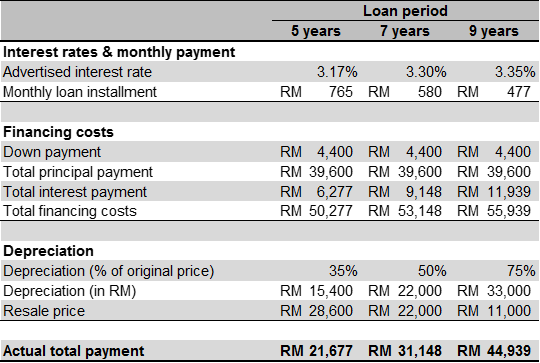
Source: Perodua and KRI’s calculations
Unsurprisingly, longer loan periods have lesser monthly loan instalments but higher total interest payments, and therefore higher total financing costs. The depreciation cost also increases with the loan periods as the wear-and-tear accumulates as the years go by.
The total financing costs are RM50,277, RM53,148, and RM55,939 for loan tenures of five, seven, and nine years, respectively. The resale prices are then subtracted from the total financing costs to arrive at the actual total payments made to procure the car. Naturally, the resale value of the car can only be recovered at the end of the loan tenure when the car is resold.
The actual total payments for loan tenures of five, seven, and nine years are RM21,677, RM31,148, and RM44,939, respectively. These come to about RM361 per month for the five-year loan tenure, and RM371 and RM416 for the seven and nine-year loan tenures, respectively.
To reiterate, the resale value of the car can only be recovered at the end of the loan period. Thus, the amount that the car owner would have to pay each month to the bank is still the monthly loan instalment listed in Table 2. So for the five-year loan tenure, the owner would have to pay RM765 per month even though the actual cost is RM316 per month after taking into account the resale value of the car.
Insurance and road tax
The other two components of fixed cost are the payments for insurance and road tax. For Perodua MyVi with a capacity of 1.3cc, the road tax is RM90 per year.
On the other hand, the insurance payment varies by the number of years that the car has been used and depends on the track record of the car owner (whether he or she has been involved in accidents). The payment decreases as the number of years increases assuming that the driver did not get into any accidents which are reported to the police.
The calculation below assumes that the car owner has a clean traffic record, that is, he or she is not involved in any accident for the entire loan period. So the insurance payment is a flat RM680 for the sixth year and beyond. Table 4 summarises the fixed costs of owning a car.

Table 4: The fixed cost of owning a car
Source: KRI’s calculations
Operating or variable costs
As was previously mentioned, there are four components of operating costs. They vary by the distance that the car travels (servicing/maintenance cost and the petrol cost) and by the number of trips (the parking fee and the toll fare).
The breakdown of the operating costs of Perodua MyVi is explained in Table 4 but before that, these are the assumptions made in the calculation:
The toll fare when we pass through Duke Highway is RM4 per trip.
The petrol price is RM1.95 per litre and the car’s fuel consumption is a prudent 15km per litre.
The parking fees when we park in or around KL Sentral on weekdays are RM20 per trip, while the parking fees on weekends are RM3 per trip.
The total operating costs for five years are RM55,008 (or RM11,002 per year), for seven years they are RM77,137 (RM11,020) and for nine years they are RM99,267 (RM11,030). Table 5 shows that the parking fees constitute more than half of the total variable costs. The parking fee in KL Sentral can go above RM20 per day. Thus, the calculation is sensitive to the rate of parking fee.

Table 5: The variable cost of operating a car
Source: Perodua and KRI’s calculations
Total costs of owning and operating a car
To get the total costs of owning and operating a car, we added up the fixed and variable costs discussed earlier. This is summarised in Table 6. To find the annual costs, the total costs were divided by the number of years of the loan tenure. The monthly costs for the five, seven, and nine-year loan tenures are RM1,347, RM1,357, and RM1,402, respectively.
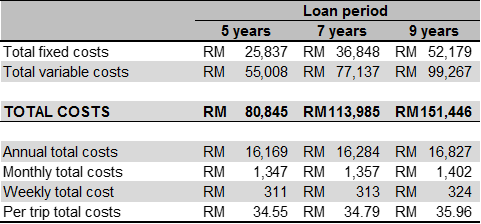
Table 6: Summary of the costs of owning and operating a car
Source: KRI’s calculations
Travelling by taxis
MyTeksi booking fee is RM2 per hire and budget taxis’ base fare for the first km is RM3. The subsequent distance is subjected to a rate of RM1.25 per-km. For a return trip of 45km, that gives us a cost of RM59.75 per trip for the regular budget taxis, and RM63.75 for MyTeksi. The monthly costs would then amount to RM2,330 and RM2,486 for regular taxis and MyTeksi, respectively. See Table 7. Based on our calculation, it looks like taking a taxi costs between 1.5 and 1.7 times more than owning a car.
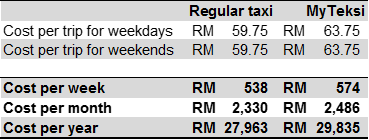
Table 7: The cost of commuting by taxis
Source: SPAD and KRI’s calculations
Travelling by Uber
In Kuala Lumpur, the base fare for Uber is RM1.50 for the first km and the subsequent fare is RM0.60 per km. For a return trip of 45km, that gives us a cost of RM28.80 per trip or RM1,123 per month, substantially cheaper compared to the regular taxis. See Table 8 for details.
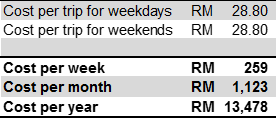
Table 8: The cost of commuting by Uber
Source: Uber and KRI calculations.
Combination of taxi and train
There are two parts to the calculations of the costs of commuting by taxis plus trains and they are each explained below.
Part I of the commute: the taxi ride between home and the train station
The calculation assumed that the taxi was booked using MyTeksi and the journey covers a relatively short distance of 3km. The taxi ride would then cost RM15.00 per trip.
Part II of the commute: the train ride between the station and KL Sentral
The LRT fare from Gombak to KL Sentral is RM2.40 one-way. The same fare applies to the return journey, giving us total RM4.80 for the cost of train fares per trip.
Combining the costs of taxi and train rides gives us a cost of RM19.80 per trip or RM772 per month, the cheapest option that we had considered so far. The breakdown of the total costs is shown in Table 9.

Table 9: The cost of commuting using a combination of taxi and train
Source: SPAD and KRI’s calculations
COMPARING OF DIFFERENT MODES OF TRANSPORT: BEYOND THE RINGGIT
The costs of the four modes of transport by year, month, week, day, and trip are summarised in Table 10. To reiterate, the most expensive way to commute between Gombak and KL Sentral is to take the taxi, and it is even costlier to consistently rely on MyTeksi to book the ride. The cheapest option would be to take a combination of taxi and train. One could point out that a possibly cheaper way to commute would be to ride the motorcycle, either by riding it all the way to KL Sentral, or a combination of motorcycle and train.
According to the Household Income Survey (HIS), in 2014 67% of households own at least one motorcycle, a rate lower than households’ ownership of car which stood at 84% during the same period. However, among the poor households, it is more common to find households which own a motorcycle (50% of poor households own at least one motorcycle) than it is to find households which own a car (30% of poor households own at least one car).

Table 10: Summary of the total costs of the four modes of transport
Source: KRI’s calculations
Money versus time
One could also point out that the calculations fail to take into account many other costs associated with commuting, one of the major ones would be the cost of time. Taking the train might cost a lot less financially but it has other downsides which may make it less preferable. One of the factors for the low share of public transport to total transport share in Malaysia is the fact that our public transport system has small area coverage, which then contributes to its low accessibility and connectivity.
A 2014 survey by the Land Public Transport Commission (SPAD) found that taking the bus may actually take more than three times as long and the LRT twice as long as driving a car in spite of congestion in the city. This is further emphasised by the multiple accidents and delays that the LRT system experienced last July that caused many workers to arrive hours late to the office. Hence, it might not be a good idea to take the public transport if one is not willing to forgo one’s time in return for lower financial costs, although this may not even be a choice for those who are not able to afford their own private vehicles.
Other unaccounted costs and considerations
The calculations also do not take into account that getting a taxi or Uber car during the rush hours can be challenging. The queue for taxis can be long and it may take some time before a transport user is able climb into one. Taxis and Uber cars are also harder to find in areas away from the urban central areas.
Moreover, taking the train is only feasible for those who live near the train stations. The trains also stop operating after a certain hour (the LRT operates between 6am and roughly 12am), making it necessary to carefully plan the commute. Thus, even though taking a combination of taxi and train is cheap, it is not a viable option for everyone. In essence, taking the public transport is not as convenient as having one’s own vehicle. The latter allows more flexibility in terms of timing one’s commuting.
On the other hand, those who dislike driving may point out that owning and operating a car also have another hidden cost – the stress of driving in Kuala Lumpur’s chaotic traffic, which can intensify during peak hours. There is also differences in, for a lack of a better word, the level of comfort among the four types of transportation. Private cars and, to some extent, taxis and Uber cars, provide greater privacy to the transport user compared to trains. So if one is not willing to share the transport, this may be an important consideration. One feature of Uber that the regular taxis do not have is a rating system which grades the drivers and the passengers. This system may provide greater level of certainty compared to the regular taxis.
Of the three more "private" form of transport, Uber is the cheapest at RM259 per week or RM1,123 per month. However, this may still be unaffordable to a large portion of the population. RM1,123 is 24% of the median household income in 2014. It is not entirely reasonable to allocate almost a quarter of the household income on transportation when there are other competing expenses that also need to be met such as housing, food, education, etc. For a large portion of the population, being chauffeured around is a luxury that cannot be afforded for the daily commute.
Moreover, taking the public transport allows one to perform other tasks during the commute such as reading, replying to emails and playing games on the phone – tasks which are not possible (or not supposed to be done) when one is behind the wheel. This may be another form of time cost.
Needless to say, there are many other considerations that need to be accounted for before we can arrive at the complete costs of the different modes of transport. If one cares about the impact of the commute on the environment and the society as a whole, then it would be necessary to consider costs such as carbon dioxide emission, energy use, etc. These and other unaccounted costs are beyond the scope of this article.
Improving the transport systems in Malaysia: Cue the government and the regulator
The government has recognised the need to improve the transportation system in Malaysia, so all is not lost. Under the National Land Public Transport Master Plan 2012-2030, SPAD had facilitated investments to upgrade and rehabilitate existing infrastructure, to construct new rail lines, and to extend existing lines. Moreover, the 11th Malaysian Plan highlighted the government’s commitment in improving the public transportation as evidenced in the Strategy Paper #13.
The Sunway Bus Rapid Transit was introduced back in June while the extended LRT lines (the Kelana Jaya LRT line from Kelana Jaya to Putra Heights, and the Ampang LRT line from Sri Petaling to Putra Heights) are expected to be completed in 2016. Meanwhile, the on-going construction of the Mass Rapid Transit (MRT) from Sungai Buloh to Kajang started in 2012 and is expected to be done in 2017.
Conclusion
This article provides a rather simplistic comparison of the costs associated with four modes of transport – personal car, taxis, Uber cars, and a combination of taxis and trains. Based on the assumption built into the calculations, we find that the last option is the cheapest of the four, followed by Uber car, personal car, and taxis.
Having said that, taking a combination of taxis and the LRT may cost less financially, but it is not as convenient as owning a car or taking the taxis. There is time cost associated with the mass transport. On the other hand, owning a car may be imperative to get to places more easily and conveniently, but it can put financial strains on the users, especially on low-income households and the younger generation of drivers who have just started working. Taking the taxis costs more than owning a car.
In view of that, the automotive sector of the sharing economy (such as Uber) is forcing its way into the market to fill the gap between convenience and cost-effectiveness. Another form of transport sharing, carpooling, is also gaining traction in Malaysia through the introduction of Tripda. Hence, the sharing economy can play its role as a platform to promote a more efficient transport system.
Despite the conclusion made from the calculations, we recognise that it is sensitive to the assumptions on which they are based. Each mode of transport has its own plus points and drawbacks, and each has its own specific context and circumstances during which it is most economical or advantageous. Trains and other mass transport such as buses are more economical for ferrying large number of people which are heading towards the same direction. They are particularly useful for weekday commute whereby most people head towards the city centres where the offices are located.
Private cars, taxis, and Uber cars are particularly useful for the ‘last mile’ of a journey. They are suitable for areas where there is relatively low or inadequate connectivity. They last two (taxis and Uber cars) are reasonable substitutes for those who are not willing to drive to the train station.
Private cars are also convenient if one wish to travel out of the city or if one is travelling in groups. Balik kampong with families and visiting house-to-house during the festive seasons are certainly more convenient with private cars. Weekend traveling to the non-urban areas such as going for berkelah at the beach are also easier by driving.
To summarise, the different modes of transport are not perfect substitutes for one another and are more complimentary than substitutive. Thus, it is up to the individuals to choose the appropriate modes of transport based on their affordability and accessibility, and for the government to craft policies such that transport users are induced to take the most efficient modes of transport for the community as a whole for the specific types of commute.








